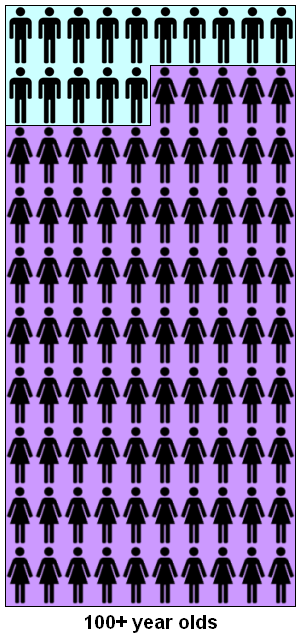Scottish life expectancy at its highest ever level
Scottish life expectancy at its highest ever level

Growing number of people living more than a century
Life expectancy at birth in Scotland has reached its highest ever level and the number of people in Scotland living for more than a century continues to grow.
Figures published today by the National Records of Scotland (NRS) show that in 2012 there were 800 people who are a century old or more living in Scotland, a rise of 280 compared with 2002.
In 2012, there were 18 male centenarians for every 100 female centenarians, compared with 11 males per 100 females in 2002.
Separate figures released by Office for National Statistics (ONS) show that since 1980-1982, male life expectancy has increased by 7.4 years and females have seen an increase of 5.4 years. Based on statistics covering 2010-2012, life expectancy is now 76.5 for males and 80.7 for females in Scotland.
Registrar General for Scotland and NRS Chief Executive Tim Ellis said:
“The number of people living in Scotland who are 100 years old or more has been steadily rising. In 2002 there were 520 centenarians increasing to 800 in 2012. The majority of centenarians are females although the proportion who are male has increased from 10 per cent in 2002 to 15 per cent in 2012. This suggests that the gap in mortality between men and women for this age group is narrowing.”
“More generally, while life expectancy at birth in Scotland is higher than it has ever been, life expectancy at birth in Scotland is still the lowest within the UK. In Scotland, males and females can expect to live shorter lives (by 2.5 years and 2.1 years respectively) than in England, where male and female life expectancy is the highest in the UK.”
Main findings from the statistics released today
National Life Tables
-
A newborn baby boy could expect to live 76.5 years and a newborn baby girl 80.7 years if mortality rates remain the same as they were in Scotland in 2010-2012 throughout their lives.
-
The gap for life expectancy at birth between males and females has narrowed from 6.2 years in 1980-1982 to 4.2 years in 2010-2012.
-
Life expectancy at birth has increased by two and a half years per decade since 1980-1982 in the Scotland for males, and by about two years per decade for females.
-
Life expectancy at age 65 in Scotland increased by 38 per cent to 17.0 years for males and for females by 21 per cent to 19.4 years in the 30 years between 1980-1982 and 2010-2012.
-
In 2010-2012 a male in Scotland aged 85 had an average further 5.5 years of life remaining and a female 6.4 years.
-
Scottish males and females have the lowest life expectancy at birth within the UK. Male life expectancy is 2.2 years lower than the UK average and female life expectancy is 1.9 years lower.
-
In Scotland, males and females can expect to live shorter lives (by 2.5 years and 2.1 years respectively) than in England, where male and female life expectancy is the highest in the UK.
-
Amongst European Union (EU) countries, male life expectancy was highest in Sweden (79.9 years), 3.4 years higher than in Scotland. Female life expectancy was highest in Spain (85.1 years), 4.4 years higher than in Scotland.
Centenarians and population aged 90+
-
A century ago living to a hundred was very uncommon, but this changed at the beginning of the 21st century when estimates showed there were over 500 people aged 100 years old and over in Scotland. The number of centenarians has been increasing ever since.
- The overwhelming majority of centenarians are women. In 2012, women accounted for 680 of Scotland’s centenarians (85 per cent) while 120 men had reached the milestone. Although the male population aged 90 to 99 increased from 2011 to 2012, almost three quarters of people in their 90s are women (73 per cent).
- The following infographic illustrates the 2012 data by looking at centenarians figures as groups of 100 people. If we were to gather 100 centenarians together then on average there would be 15 men and 85 women.
Number of males and females per 100 centenarians, Scotland 2012
- Since 2002, the number of centenarians relative to the rest of the population has increased. But there are still less than 2 centenarians for every 10,000 people (1.5 per 10,000).
The full publication Centenarians in Scotland, 2011 & 2012 is available on the NRS website.
NRS also published today the Scottish National Life Tables on the NRS website.
